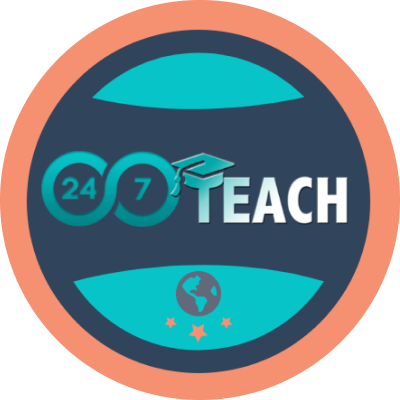Lesson 3: APA Citations & Style
Prefer to listen to directions? Use the audio file below.
Lesson 3 Scenario:
Imagine yourself in the following scenario:
You are a student pursuing a career in aviation. You have almost completed your technical training and will soon enter your on-the-job training. However, during a training simulation, you had a miscommunication with your team that could have led to unsafe conditions for the aircraft and passengers. You realize that while you have learned the technical skills necessary for the job, you haven't had much experience with the communication skills required for the position. You speak with your supervisor, who advises that you take an English 101 course hosted by 24/7 Teach to help you become an effective professional communicator.
You now know that it is important to gather credible sources and cite those sources to boost your own credibility when responding to arguments and others.
Now it is time to explore other citations methods to continue boosting your credibility. While it is good to come across as credible, you need to have a way to communicate the data and resources that you have discovered. Your next step is to develop your own style of writing and communicating with others and what types of communication is appropriate in different situations.
Lesson 3 - Objectives and Directions:
Objectives: After successfully completing this lesson, you will be able to:
Differentiate between academic and civil reading audiences.
Think critically about texts, and clearly communicate ideas for writing.
Cite sources in APA format to avoid academic dishonesty and plagiarism, and to build your credibility.
Describe an author’s style and tone in various works.
Evaluate sources for credibility and coherence.
Lesson 3 - Vocabulary:
Click on the button below to preview the essential vocabulary for this lesson. Once you complete the readings, you will need to correctly use at least 3 vocabulary words in your assessment or discussion responses, using the following criteria:
Include 2 vocabulary words in any of your written responses (assessment or discussion)
Include 1 vocabulary word in your audio or video response
In the assessment below, list the 3 vocabulary words you have chosen to use in your responses
Lesson 3 - Presentation and Readings:
Review the following Presentation: (Click here if you wish to download the presentation)
Your required readings for this unit will include chapters from the textbook, Everyone’s an Author, and supplemental excerpts, “The days of 'fun flying' are long gone: How U.S. air travel became a nightmare” and “Breaking: Ryanair Places Huge Order For Up To 300 Boeing 737 MAX 10s.”
Click on each title below to read the text introductions and to access the links to the reading. Take notes as you read.
-
Welcome to Chapter 28 of Everyone’s an Author. In this chapter, we will look at APA or American Psychological Association citations, a standardized format used in academic writing to give credit to the original sources of information and ideas. It provides a consistent and clear way of referencing various types of sources, including books, articles, websites, and more. Using APA citations is essential to uphold academic integrity, demonstrate respect for intellectual property, validate your claims, support your arguments, and avoid plagiarism. It promotes clarity, consistency, and the ethical use of information in academic writing. By the end of this chapter, you will have the tools to cite sources correctly in APA format whether in-text or on a reference page.
-
Welcome to Chapter 29 of Everyone’s an Author. This chapter examines the importance of appropriateness in writing style and how style should suit the topic, purpose, stance, and audience. While there are no strict rules to follow, being appropriate is more crucial than adhering to traditional conventions. The text also highlights the importance of considering the levels of formality and the writer's stance towards the topic and audience. By the end of the chapter, you should be mindful of your style choices in different writing contexts and what is appropriate or not.
-
Welcome to Chapter 30 of Everyone’s an Author. This chapter explores the relationship between social media and writing skills. It highlights the similarities in rhetorical thinking required for both social media and academic writing, emphasizing the importance of considering the audience, purpose, and medium in both contexts. We’ll also look at how social media can be used for academic purposes, such as responding to videos or following scholars on Twitter. Additionally, we’ll discuss the differences in writing strategies between social media posts and academic essays, including the need for careful argumentation and citation in academic writing. We’ll conclude by emphasizing the importance of evaluating sources and considering the intended audience in all forms of writing, whether formal or informal, online or offline.
-
Welcome to Chapter 31 of Everyone’s an Author. This chapter highlights the importance of crafting effective and memorable sentences through attention and practice. While not everyone may create a sentence as remarkable as Shakespeare, a well-crafted sentence can bring power to writing. We’ll look at the four basic sentence structures: simple, compound, complex, and compound-complex. Varying sentence length and flow can help establish the intended emphasis and maintain reader engagement. Finally, we’ll look at how to break up a series of long sentences with shorter ones to create effective rhythms and give readers moments to pause and absorb the content.
-
Supplemental Reading 1 - “The days of 'fun flying' are long gone: How U.S. air travel became a nightmare.” This text discusses some of the more recent air travel issues in the United States.
Directions: Read the article called “The days of 'fun flying' are long gone: How U.S. air travel became a nightmare.” Click on the link below to access the full text.
Supplemental Reading 2 - “Breaking: Ryanair Places Huge Order For Up To 300 Boeing 737 MAX 10s.” This text looks at the recent order placed by European low-cost carrier, Ryanair.
Directions: Read the blog entry “Breaking: Ryanair Places Huge Order For Up To 300 Boeing 737 MAX 10s.” Click on the link below to access the full text.
Lesson 3 - Practice 1:
Use what you’ve learned from the chapters in this lesson to complete the following:
Locate the errors in the citation below. Then, make the corrections by redoing the citation properly. Hint: There are 3 errors in this citation.
Jackson, Lucas Mark. (October 14, 2019, 2:16 pm). The psychology of prejudice: From attitudes to social action (2nd ed.). american psychological association. https://doi.org/10.1037/0000168-000
-
The correct format:
Jackson, L. (2019). The psychology of prejudice: From attitudes to social action (2nd ed.). American Psychological Association. https://doi.org/10.1037/0000168-000
Error #1: In APA format, you include the author’s last name and first initial. You do not include the full name.
Error #2: The entire date and time of publication is not needed. You only need the year of publication.
Error #3: The organization or overall source where the article or chapter comes from must be capitalized. Articles and chapters may not always be capitalized because some are published with lower case letters.
Lesson 3 - Practice 2:
Use what you’ve learned from the chapters in this lesson to complete the following:
Read the following articles. Then, answer the question that follows.
https://www.boeing.com/commercial/market/commercial-market-outlook/index.page#/asia
Which of the following articles is a more credible source? Explain your reasoning and use examples from the articles.
Lesson 3 - Assessment:
Click on the button below to submit your responses to the following questions. (For question 3, submit an audio recording*. See directions on how to record and submit your audio below.)
You may use the conversation starters found in the lesson directions to support your answers.
What is the importance of selecting an appropriate writing style when communicating with your audience?
Why is it important to evaluate the reliability of a source such as a news article or image posted on social media?
AUDIO SUBMISSION*: Why is it essential to cite your sources if you use an outside resource in your work?
Participate in our discussion below
↓
Participate in our discussion below ↓
Lesson 3 - Discussion Activity:
Participate in our discussion by posting your responses to the questions in the comments section below. (For question 3, submit a video recording*. See directions on how to record and submit your video below.)
You may use the conversation starters found in the lesson directions to support your answers.
Think about a time when you had to communicate a message to a specific audience. How did you decide on your communication style? What kind of stance did you take? What kind of tone did you use? Did your choices work for the audience and yourself? Explain.
Compare and contrast the rhetorical situation of "The Days of ‘Fun Flying’” and “Ryanair.” How do the styles, stances, and contexts of these two pieces of writing differ? What impact does this have on the way the messages are communicated?
VIDEO SUBMISSION*:Think about a time your intentions were misunderstood because your tone was disliked by the audience. Then, record a video response to the following questions:
What did you do to fix the situation? If you didn’t change the situation, what could you have done?
What kind of tone should you have used instead?
Why is it important to keep tone in mind when writing and/or speaking?














